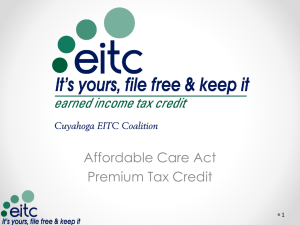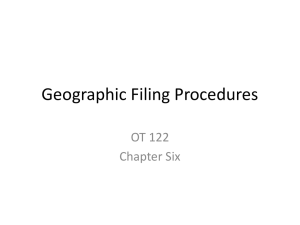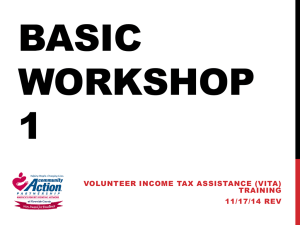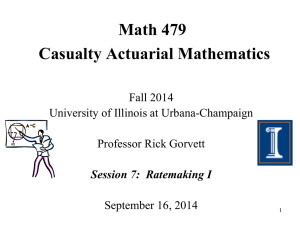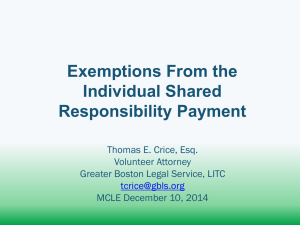Advanced Premium Tax Credit
advertisement
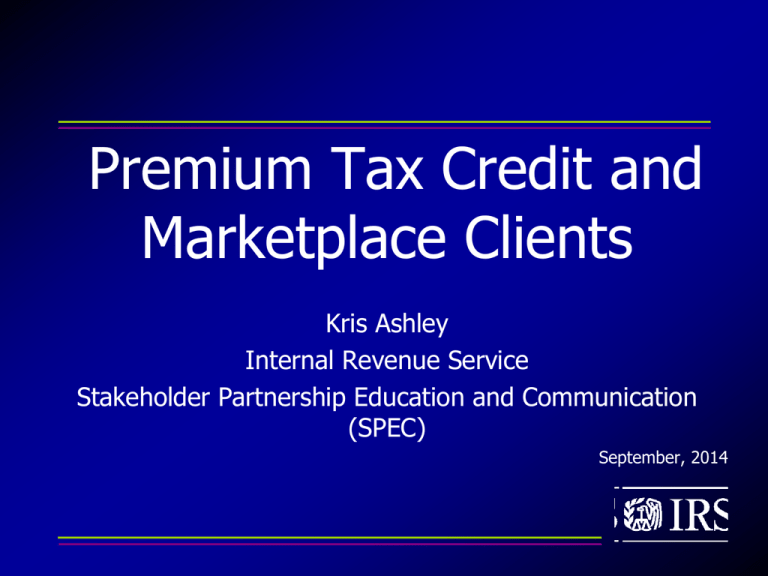
Premium Tax Credit and Marketplace Clients Kris Ashley Internal Revenue Service Stakeholder Partnership Education and Communication (SPEC) September, 2014 What is the Premium Tax Credit? • Refundable tax credit • To help eligible individuals and families pay for health insurance • Two payment options: • Get it Now – advance credit payments • Get it Later – without advance credit payments Premium Tax Credit Taxpayers may be eligible for the credit if they: • Are eligible for and have purchased and paid for health insurance through the Marketplace; • Do not file a Married Filing Separately tax return (except certain victims of domestic abuse); • “Household income” is at least 100% and no more than 400% of the Federal Poverty Line; and • Cannot be claimed as a dependent by another person. Advanced Premium Tax Credit • • “Get it Now” option Monthly amount, based on: • • • • • • taxpayer’s estimated number of dependents taxpayer’s estimate of household income Second-lowest cost silver plan premium Paid directly to insurer A tax return must be filed to reconcile estimate with actual income and family size. Differences between advance credit payments and the credit are likely. Tax Terminology…. Filing Status • • • Single – not legally married on Dec. 31 of the tax year Married Filing Jointly – legally married on Dec. 31; includes taxpayers whose spouse passed away after the start of the tax year. Married Filing Separately – legally married but doesn’t want to file joint • If MFS, then NOT eligible for Premium Tax Credit unless qualified for an exception as a victim of domestic violence Filing Status • Head of Household • • • • • Unmarried (or “considered unmarried”) Paid more than ½ the cost of keeping up the home where taxpayer lived with a qualifying person for more than ½ the year (exception if the qualifying person is a parent) Qualifying person can be child, or a close relative that is also claimed as a dependent. A married taxpayer can be “considered unmarried” for Head of Household if: • • Lived apart from spouse for the entire last 6 months of the year Qualifying person must be child or step-child taxpayer can claim as dependent Filing Status • Qualifying Widower • • • • Spouse died in 2012 or 2013 (not 2014) Paid more than ½ the cost of keeping up the home where TP lived with a dependent child or stepchild for more than ½ the year AND Not remarried Who is the “tax family”? A tax family includes the individuals for whom the taxpayer claims a personal exemption deduction on the return, including: • the taxpayer • spouse • and any dependents. Tax family - Who is a dependent? To be a dependent: • • • • The taxpayer claiming the dependent cannot be a dependent on another TP’s return. A dependent cannot file a joint return unless no tax liability would exist for either spouse on separate returns. Dependent must be U.S. citizen, U.S. resident alien, U.S. national, or a resident of Canada or Mexico, for some part of the year. A dependent must be either a qualifying child or qualifying relative. Qualifying Child Dependent • Relationship Test – Child, brother or sister (or a descendant of one of these), or a foster child placed by an authorized agency • Residency Test – Child must have lived with TP for more than half of tax year • Age Test – under 19, full-time student under 24, or permanently disabled at any age • Support Test – dependent cannot provide more than ½ of own support Qualifying Relative Dependent Not a Qualifying Child • Member of the TP’s Household for all year or close family relationship (closer than cousin) • Gross Income Test - less than $3950 for 2014 • Support Test – TP must have provided more than ½ of dependent’s total support • Need help figuring out dependent or filing status? • • Use the “Interactive Tax Assistant” at http://www.irs.gov/uac/Interactive-TaxAssistant-(ITA)-1 Or go to www.irs.gov and search on “ITA” or “interactive” Household Income Modified Adjusted Gross Income (MAGI) = total of: Adjusted Gross Income (AGI) – Form 1040, line 37 + Tax Exempt Interest – Form 1040, line 8b + Foreign Earned Income Exclusion and Housing Deduction (Form 2555 or Form 2555-EZ) + Non-Taxable Social Security Benefits (difference between Form 1040, line 20a and line 20b) Household income = combined MAGI of all members of the tax family with a filing requirement Who has a Filing Requirement? If your filing status is… Single Married Filing Jointly Married Filing Separately Head of Household Qualifying Widow(er) THEN file a return if AND at the end of 2014 you your gross income was were at least… under 65 65 or older under 65 (both spouses) 65 or older (one spouse) 65 or older (both spouses) any age under 65 65 or older under 65 65 or older $10,150 $11,700 $20,300 $21,500 $22,700 $3,950 $13,050 $14,600 $16,350 $17,550 Dependents with more than $1,000 in unearned income must file a return – this year, all dependents receiving a PFD will have a filing requirement. Advanced Premium Tax Credit During enrollment through the Marketplace, the Marketplace will estimate the amount of the premium tax credit you will be able to claim on your tax return. If you are eligible for the credit, you can choose to: • Get It Now: have some or all of the estimated credit paid in advance directly to your insurance company to lower what you pay out-of-pocket for your monthly premiums; or • Get It Later: wait to get all of the credit when you file your tax return. Calculating the Premium Tax Credit To calculate the PTC, you need to know: • The size of the tax family • Household Income of the tax family • Second Lowest Cost Silver Plan (SLCSP or benchmark) for the covered individuals – might change from month to month • SLCSP is provided to the taxpayer on Form 1095-A It is important to note that the calculation of advance payments of PTC is based on estimated income; however, final eligibility for the PTC is calculated with the actual income on the Form 1040. Reconciling the Credit on the Federal Tax Return • Consumer must file a tax return and complete Form 8962. • Form 8962 calculates the credit based on actual household income and family size from the tax return • If TP chose to “get it later”: The full amount of the premium tax credit is claimed on the tax return. This will either increase the refund or lower the balance due. Reconciling the Credit on the Federal Tax Return • If TP chose to “get it now”: total advance payments will be subtracted from the amount of the Premium Tax Credit calculated on the tax return. • • • If the actual Premium Tax Credit is more than the advance payments, the difference will reduce the amount owed on the return, or increase the refund. If the advance credit payments are more than the Premium Tax Credit, the difference increases the amount owed on the return, or decreases the refund. The repayment of excess Advanced Premium Tax Credit is limited for consumers who income is below 400% of Federal Poverty Level. Reconciling the Credit on the Federal Tax Return Form 8962, page 2 allows for special calculations for: • allocating shared policies • people who married during the year People who divorced during the year may agree to allocate, but must use the same proportion for the benchmark plan, premium amount, and advance credit. • If they can’t agree – split 50/50 Other situations… For purposes of the credit, premiums paid by someone else are treated as having been paid by the taxpayer “Changes in Circumstance” Taxpayers should alert the Marketplace about any change in circumstance that could affect the Premium Tax Credit: • Change in income • Change in family size • Change in address For example … • • • • • Mary is 26, unmarried, and lives in Anchorage. Her two young nephews live with her, and she will claim them as dependents. They are eligible for Denali KidCare. She estimated her household income for 2014 would be $30,000 (123% FPL for a family of 3) She qualifies for $296/month Advanced Premium Tax Credit Her silver plan premium is $305/month, before the credit. She chose to “Get it Now”, so she pays only $9/month out of pocket after the APTC. Now it’s tax time for Mary… • • • Mary has $29,400 of wages plus an $1,800 PFD. Both kids received the PFD, and had no other income. Her actual household income is $33,000 (135% FPL) Her Form 1095-A says: • • • Her annual premium cost was $3,660; The benchmark premium (SLCSP) was $4,164; and Her Advanced Premium Tax Credit amount is $3,552. Tax time for Mary … • • • • Based on her actual income of $33,000 she’s entitled to a Premium Tax Credit of $3,091. Mary has $461 “excess advance premium tax credit” ($3,552 – $3,091 = $461) Because her Household Income is less than 200% of FPL, her repayment is limited to $300 The $300 excess PTC must be repaid with her tax return, reducing her refund or creating a balance due. Things to keep in mind • • • • Tell the Marketplace about any changes to income and family size (handouts) Don’t forget the PFD for everyone when estimating household income! Form 1095-A and Exemption Certificate Numbers will be needed for the tax return. A tax return must be filed if the Advanced Premium Tax Credit is received Free tax help is available • Call 2-1-1 to find the closest volunteer site • Contact Alaska Business Development Center at 1-800-478-3474 * * * * • Aleutians Interior Pribilofs Yukon Delta * Bering Strait * Kodiak * Southeast * Bristol Bay * North Slope * Western Go to www.myfreetaxes.com/alaska or www.irs.gov/freefile Questions? Thanks for having me!
